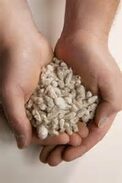THE COTTONSEED DILEMMA
 In 1793, Eli Whitney invented the cotton gin, a machine that was able to mechanically separate the cotton fibers from the cottonseed and thus allow for cotton to be mass produced. While cottonseed was initially plowed back into the ground to fertilize the soil, it eventually began to be used to feed farm animals because of its high protein content.
In 1793, Eli Whitney invented the cotton gin, a machine that was able to mechanically separate the cotton fibers from the cottonseed and thus allow for cotton to be mass produced. While cottonseed was initially plowed back into the ground to fertilize the soil, it eventually began to be used to feed farm animals because of its high protein content.
The dilemma farmers faced was that because cottonseed contains several toxic constituents, many animals fed cottonseed died, especially pigs. Animal studies revealed that ingestion of cottonseed meal resulted in internal bleeding, abnormal blood clotting, fluid in the lungs and heart failure.
Because of the desire to continue reaping the benefits of cottonseeds high protein content, researchers worked to establish levels of cottonseed consumption for animals that would not cause their death. This has allowed farmers to continue feeding cottonseed to their animals, a practice that has been going on for around 150 years.
Currently, around 5.7 million tons of cottonseed is produced annual in the US. Much of this is used as feed for livestock. In addition, more than 154 million gallons of oil is extracted from cottonseed and used in the making of bakery products, potato chips, margarine and salad dressing.
Of interest is the fact that farmers cannot feed cottonseed to egg laying chickens because cyclopropenoid fatty acids (CPFA’s) in cottonseed turn egg whites pink. CPFA’s have also been shown to interfere with an animal’s ability to excrete cholesterol. CPFA’s are not eliminated in the making of cottonseed oil.
A major toxin in cottonseed is gossypol. Gossypol is produced by pigment glands in cotton stems, leaves, seeds, and flower buds. These glands appear as small black spots distributed throughout the cotton plant. It is in the cottonseed that the greatest concentration of gossypol is found. Gossypol appears to provide the plant with protection from pathogens and insects. Therefore, it acts as a natural pesticide produced by the plant itself.
Gossypol has been shown to be toxic to the liver, kidneys, heart, and reproductive system. Gossypol exists in two forms: free and bound. The free form is toxic. The bound form binds to proteins and is not toxic in this bound state but can become toxic if it becomes unbound which it can do. Additionally, the binding of gossypol to proteins reduces the availability of amino acids for absorption by the animal with the amino lysine being the most affected. The concentration of free gossypol in cottonseeds can vary depending on the species of the cotton plant, soil and climatic conditions and other factors such as the type of fertilization of the soil.
Gossypol is removed in the making of cottonseed oil but it remains present in the cottonseed meal fed to farm animals. While the amount of cottonseed meal fed to animals is regulated to avoid the negative effects of gossypol, the fact remains that when animals are fed cottonseed they are also ingesting gossypol and when we eat the meat of these animals, we are ingesting gossypol as this substance remains in the fatty tissue of animals. Gossypol is not readily eliminated from the body. The concern is that over time gossypol can accumulate in the body and lead to various health problems.
Gossypol has been shown to decrease the production and motility of sperm in human males. This can result in decreased male fertility. In the past, the Chinese actually used gossypol as a form of contraception. Gossypol also tends to interfere with the metabolism of potassium. Low potassium can cause a variety of health problems. Another toxic effect of gossypol is its interference with immune function. It has been shown to reduce an animal’s resistance to infections. There also is evidence that gossypol damages DNA. In addition to the toxins found in the cottonseed, it is to be noted that cotton plants are heavily treated with pesticides and herbicides. Pesticides and herbicides are known carcinogens.
While there are multiple studies showing the toxicity of cottonseed to animals, little research has been done to examine the effects on human health of gossypol, cyclopropenoid fatty acids and other substances found in cottonseed. Agriculture and the cotton industry have a vested interest in using cottonseed as feed for animals and as a source for inexpensive oil for the food processing industry. It is very difficult to obtain funding for research that may produce evidence that cottonseed consumption may be harmful to the health of humans.
Recently, Dr. Bruce Semon, who holds a Ph.D in nutrition and is a board certified psychiatrist, funded his own research in conducting a series of experiments using rats that were fed cottonseed. Dr. Semon’s research identified association between the consumption of cottonseed and various health problems including Alzheimer’s disease. Dr. Semon’s research can be viewed in his recently published book entitled “Rottenseed!, Cottonseed, Alzheimer’s and your brain.” This book is available at Milk ‘N Honey.